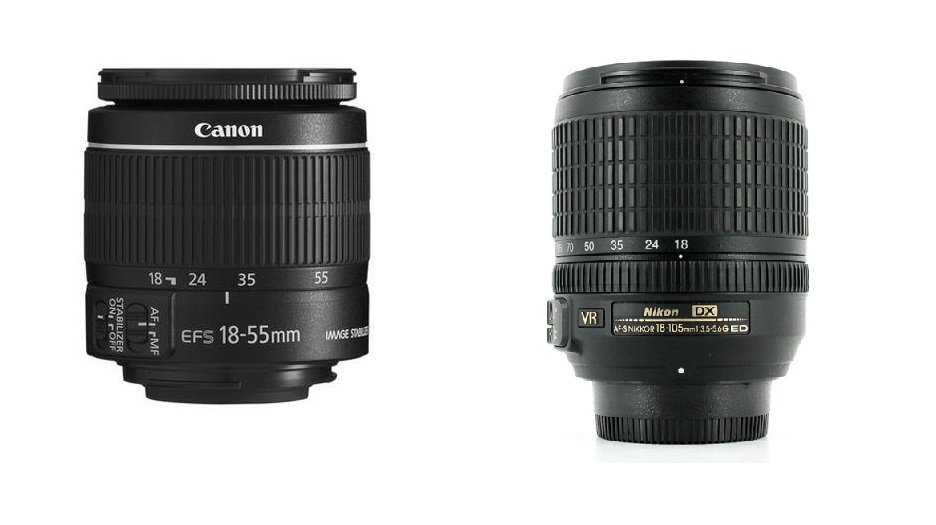When everyone started using DSLR lenses, I felt confused: What does the name Canon EF 70-200mm f/4.0 L IS USM mean? What is Nikon DX AF-S NIKKOR 18-55mm 1:3.5-5.6 GII ED? This string of abbreviations is almost like a strange language to novices. Today, let us use some lens labels from Canon and Nikon to tell you the meaning and usefulness of these abbreviations. I hope you can understand more about them.
Kit Lens is often our first lens as a companion for novices, but how much do we know about them? Let’s take a look, Canon 550D and Nikon D90 these two very popular “newbie first machine”, what kind of technology does their Kit Lens include? We can see from the label on the lens.
Canon EF-S 18-55mm f/3.5-5.6 IS
EF-S
This lens with focal length (18-55mm) have always been the standard configuration of Canon’s novice level. Starting from the name, we can already get some information. After the Canon brand name, we first saw this abbreviation-EF-S. What does this mean? In fact, Canon’s current lenses have two types of mounts, one is EF and the other is EF-S. EF corresponds to the full frame body, and the EF-S mount lens corresponds to the APS-C format sensor body. The EF format lens can be used in the APS-C format sensor body, but the full-frame body cannot use the EF-S format lens. This should be paid attention to when buying!
18-55mm
This data is the focal length of the lens (that is, it can be Zoom far or zoom close). 18(mm) represents the widest end of this lens, 55(mm) represents the longest end of this lens
f/3.5-5.6
This data refers to the maximum aperture that the lens can use at different focal lengths (note that it is not the range of aperture that can be used, and novices most often misunderstand). In fact, the aperture value is not only determined by the physical size of the aperture, but also the length of the lens, the aperture, the amount of light entering, and the loss of light caused by the lens combination. Therefore, when the lens is zoomed, the aperture value naturally changes. f/3.5 refers to the maximum aperture of the lens at the widest angle end (18mm), and f/5.6 refers to the maximum aperture at the farthest end (55mm). Of course, “Widest Angle” and “Farthest End” will be different for different lenses.
IS
This is an anti-shock and vibration technology developed by Canon. Use the floating lens system in the lens, plus the built-in CPU, to compensate for the shift of the optical axis caused by hand shake. The EF-S 18-55mm f/3.5-5.6 IS adopts a micro structure. The traditional anti-shock system of a higher-level lens is simple, but it still has four levels of anti-shock.
DC motor
Canon EF-S 18-55mm f/3.5-5.6 IS uses a DC motor instead of the USM used by most lenses. In contrast, the USM (Ultrasonic Motor) is faster and quieter. Moreover, this lens rotates the front end of the lens body when focusing, which may cause inconvenience to the use of CPL polarizers or star filter
Nikon AF-S DX NIKKOR 18-105mm F3.5-5.6G ED VR
This lens is one of Nikon’s very popular novice level cameras-D90 Kit Lens. This lens uses a variety of Nikon expertise technology.
AF-S
Nikon’s AF-S and Canon’s EF-S are similar in name, but in fact they are completely different things. Nikon’s AF-S refers to the lens that is equipped with a Silent Wave Motor (S), and is powered by “Traveling Waves”. for optical focusing, which can focus quickly and accurately and quietly. And it can focus manually all the time, even when Auto-focus is turned on, you can still manually turn the focus ring to focus at the same time without damaging the lens.
DX
Nikon’s DX format has the same meaning as Canon’s EF-S format. It is a lens developed by NIKKOR for cameras in the APS-C sensor format. Similarly, a DX format lens used in a full-frame camera will have black corners.
NIKKOR
Nikkor is a brand that Nikon specializes in producing lenses. Historically, Nikon has many brands and specially classified brand as well. Nikkor is a brand created by Nikon in 1932 to make lenses for Nikon F-MOUNT. It is still in use today, and most Nikon lenses will bear the Nikkor brand.
18-105mm
The same reason as above 18mm represents the widest end of this lens, 105mm represents the longest end of this lens . But one thing worth noting is that the magnification of the Nikon APS-C format is marked by the focal length multiplied by 1.5, which is not the same as the Canon multiplied by 1.6. Therefore, 18-105 mm used on D90 is approximately equal to 27-158 mm (18X1.5-150X1.5).
F3.5-5.6
Same reason as Canon
G
G lens is a new model designed by Nikon. There are two biggest differences between this lens and the previous D-type lens: (1) No aperture ring: Since the film era, the aperture value can be adjusted manually from the lens, but now most of the aperture value is set in the camera body , So the aperture ring of the lens body is cancelled to reduce weight and cost. (2) Support new technology 3D Color Matrix Metering: This new technology can achieve more accurate metering effect
ED
ED refers to Extra-low Dispersion lens. This technology was developed by Nikon to reduce the dispersion caused by the fold lines of light in the lens. The so-called dispersion refers to an error that the lens cannot completely restore the color of light. Adding low-dispersion ED lenses can help improve this error
VR
VR is the abbreviation of Nikon’s “Vibration Reduction technology”. Like Canon’s IS system, it effectively prevents blur caused by hand shake. The two are similar in structure, but use different algorithms.
IF
Internal focusing technology refers to focusing by the floating lens system inside the lens, the lens barrel will not rotate when focusing, quiet and fast. It is very convenient to use CPL polarizing lens or star filter.
SWM
Silent Wave Motor as explained on AF-S section above.
Written by Collin Smith @ remotes.works Holborn London

 My Account
My Account 


